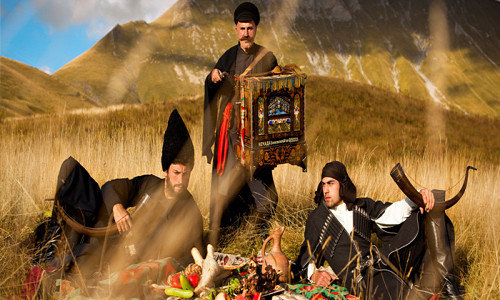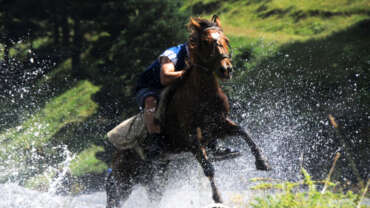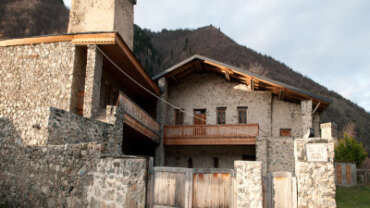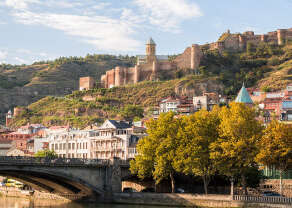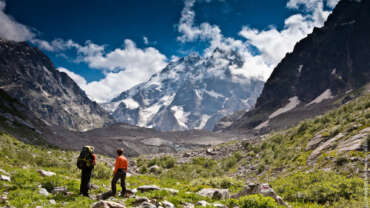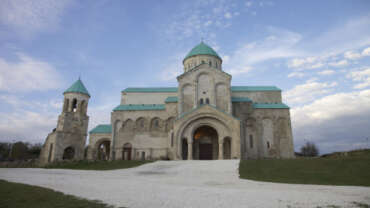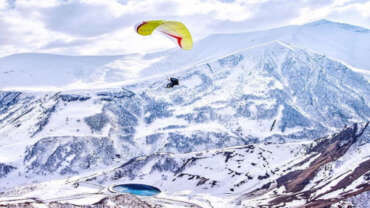Experiences in Georgia
Wine
Many discoveries left the historians no doubt that Georgia was the birthplace of wine. Ancient wine vessels made of clay, bronze and silver; golden wine cups; wine barrels dated to the 2nd or even 3rd millennium BC, as well as vine seeds found in the ancient tombs of the Bronze age outline a continuous story of the history of Georgian wine. Today, over 500 varieties of grapes grow in our small country, and Georgian wines are well known for their unique properties and characteristics. Our warm climate and moist air from the Black Sea provides perfect conditions to produce superb wine. Our diverse landscape and climate zones enable us to produce far more varieties of grapes than virtually any other country in the world.
Main grape varieties in Georgia: White grapes: Rkatsiteli, Mtsvane Kakhuri, Khikhvi, Kisi, Kakhuri Mtsvivani, Chinuri, Goruli Mtsvane, Tsolikouri, Tsitska, Krakhuna, Rachuli Tetra, Sakmiela, Avasirkhva. Red grapes: Saperavi, Tavkveri, Otskhanuri Sapere, Shavkapito, Alekhandrouli, Mujuretuli, Dzelshavi, Usakhelouri, Orbeluri Ojaleshi, Ojaleshi, Chkhaveri. The Rkatsiteli grape creates a robust white wine full of character, with many varieties and brands. The increasingly famous red Saperavi grapes provide powerful and fiery wines with aroma of plums, spices and almonds. In Kakheti region you will also discover the delicious naturally formed semi-sweet wines of Kindzmarauli and Akhasheni.
Rtveli
Traditional harvest festivities in family circle belong to those distinctive Georgian traditions that still live. Despite the fact that nowadays young people prefer to live and work in the cities, in the fall many of them come to their ancestors’ land and grandparents’ homes to meet the whole family and take part in a ritual, which is almost as old as Georgia itself.
You may wonder, what is special about harvest, while it’s a normal part of agricultural routine. However, considering how deep the roots of viticulture in Georgia are – 8000 years old tradition is a lot! – one can imagine the meaning of production and consumption of wine for all the Georgians. Taking care of vines requires a lot of effort – no wonder that there is a saying that one needs to shed one’s own sweat over the vineyard to get a good harvest. So rtveli, the harvest time in Georgia, is crowning the natural cycle and starts a new one.
Every guest to Georgia can take part in rtveli – any vineyard owner is pleased by offered help and interest in the process of birth of wine. If you want to be involved into the ancient tradition, you should learn some special words for traditional tools related to winemaking.
Godori – an oblong basket, to where one puts the picked grapes.
Satskneheli – a wooden tub, where the grapes are being pressed – people usually do it with their feet wearing special footwear. In satskheneli there is a hole, from which the juice flows into a special vessel.
Qvevri – a clay vessel, where the grapes undergo the fermentation process. These egg-shaped amphoras are the birthplace of natural flavourful wine!
Marani – a cellar, where qvevris are being buried, and the fermentation process goes on. Ready wine is also stored there because of the temperature level.
From the harvest products not only wine is being produced. Grape pomace is a base for chacha, strong Georgian brandy, which warms you up if you are cold in winter. Pelamushi and churchkhela, natural Georgian sweets, are made of grape juice and flour.
Of course, after hard work on the vineyard, all people gather at the traditional Georgian festive table to have rest and enjoy delicious meals. Lots of mouth watering Georgian dishes, flowing wine and songs – the voice of ancient Georgia can be heard in this eternal flow!
To learn more about the history of wine-making traditions of Georgia, check out our website section “Cradle of wine”, but better come to Georgia this fall and harvest pleasant emotions and memories!
Kazbegi
You may try delicious Georgian food and different Georgian drinks from lemonade to chacha in various cafes and restaurants. However, one of the best ways to experience and understand Georgian traditions of eating, drinking and enjoying life is Supra, the Georgian table. It shouldn’t always have a festive reason: every day can be festive in Georgia. Gathering with friends and family is very important here. If the guests are attending supra, it is even merrier.
So if you are invited, don’t be shy: try all the dishes (it’s a big pleasure for the hosts if their guests are full and happy), join the toast-master, take wine with the others and say some warm words too. The order of toasts is not always the same: it varies from region to region, but generally the first glass should be drained for God and peace, because both play very important role for every Georgian. If you learn the phrase “Gmerts dideba chven mshvidoba” (“May the God’s greatness bring you peace”), it would be really appreciated.
Spa & Wellness
More than 2000 springs are discovered in the territory of Georgia, which were used by local population for a long time. It is considered that mineral waters cure different diseases faster than the medicines. The influence of mineral waters is more increased if it is accompanied by air of mountains, sun rails and the greenery around.
The spa town of Borjomi, 150 km (93 miles) west of Tbilisi, developed by Tsar Nicholas in the 19th century as a spa town, produces much acclaimed mineral water. It is possible to hike in the surrounding hills.
Resort Tskhaltubo is located in the west of Georgia, in the ravine of the river “Tskhaltubo”, in 7km from Kutaisi, in 250 km from the capital city of Georgia – Tbilisi and in 70 km from the Black sea. The resort is located at 95-120 m above the sea level. Mineral water of Tskhaltubo has become a symbol of healthy life for a long time. That is why such unique gift of nature is called “Water of Immortality”. The healing properties of Tskhaltubo waters are famous from ancient times. Nowadays modern medical equipment gives us a possibility to improve treatment results.
Don’t miss a chance to visit Tbilisi sulphur baths which are located in a domed, oriental-style 19th-century bath places just north of the Metekhi Bridge. Currently very popular place, Georgian sulfur baths were also frequently visited by famous Russian writers such as Pushkin and Tolstoy.
Intrigued? Great! The names you should put on your map are as follow: Kvareli (for wine spa), Borjomi, Tskaltubo, Sairme and Likani (for various kinds of mineral water treatments). Don’t forget to visit Tbilisi sulfur baths, as you travel to the Georgian capital!
SHORT TBILISI GUIDE FOR FAMILIES
A lot of families come to Tbilisi for city breaks in the wintertime. Delighted by this, we prepared a little guide to Tbilisi and Georgia for our guests. Hope that you will enjoy your stay here!
WEATHER, TRANSPORT AND MONEY
Wintertime in Tbilisi is not cold, sub-zero temperatures is a rare phenomenon, but often it is quite windy, so a hat and a scarf are worth being packed in your bag. If you decide to continue your trip to Batumi or Imereti region, expect the air to be more humid – after all, it is a subtropical zone.
In every Georgian airport both official and unofficial taxis will not leave you standing alone with your luggage in the middle of the arrivals hall. In addition to taxi, from the Batumi airport there is a bus to the city; Kutaisi airport cooperates with Georgian Bus company, which makes regular trips to Tbilisi, Batumi and Mestia, and from Tbilisi airport there are regular daytime and night buses to the city center.
In all the shops, hotels and restaurants in Georgia you can only pay with the national currency. Of course, many hotels put prices in dollars on their websites, but they make it rather for convenience, as not the whole world keeps in mind the exchange rate of our small but proud lari. In short, when you arrive at the airport, look for a bank branch or an exchange to pay for a taxi.
PLACES TO SEE IN TBILISI
The historical sights of Tbilisi require a full day walk. Start with a cable car trip to Narikala fortress (VI century), walk down to the Abanotubani (Sulfur Bath District) and Leghvtakhevi Waterfall, continue to the streets of Old Tbilisi, including Shardeni area (a tip: your kids with love Luca Polare ice creams and frozen yogurts!).
Take a walk in Rike Park and get to see a magnificent Sameba (Trinity) Cathedral. Make a break with khachapuri and Laghidze lemonade in the yard of Sameba and walk down again.
After crossing the Dry Bridge with antique market near it, get to the pedestrian part of Aghmashenebeli Street that used to be a part of the German colony. Walk towards Marjanishvili Square, cross the bridge towards Rustaveli Avenue and continue there.
Climb upwards to the lower funicular station (it started operating in 1905!) and go to the top of Mtatsminda mountain. This is the best viewpoint! Your kids will love the amusement park and a ride on a Ferris Wheel.
Don’t forget to check the main museums:
– National Museum with its collection from Dmanisi, where the first European species of Homo were from, with its golden treasury and Museum of Soviet occupation too.
– National Gallery that houses permanent exhibitions of the Georgian painters of different centuries and hosts temporary exhibitions of Georgian and international artists every 2-3 months.
– The Ethnographic Museum and Kus Tba (Turtle Lake) are also a great place to be with kids.
Note down: all museums are closed on Monday.
After you are done with this, go to the famous sulfur baths in the historical Abanotubani district or at Lisi Lake. Your body will be grateful!
Best Retreats In The Mountains Of Georgia
Mountainous regions of Georgia are both challenging and relaxing place, where you can distract yourself from your daily routine and discover the new edge of self. It’s not just a nice sentence each media uses for description of a travel destination. It is real: even though our highlands are not that well groomed and broadly advertised as Alps or Himalayas, they offer you great authentic experiences of simplicity and hardship of local life.
Recently Georgians from rural regions and mountains started re-making their homes to guest houses, so the accommodation market is growing. Some rural areas like Kazbegi or Mestia can even offer a luxury stay in an incredibly pure environment. It depends on you, what kind of retreat you prefer: spa hotel with a view, a room in a little wooden house or a tent in the middle of nowhere.
Let’s talk about the destinations now. In Georgia, there are several main destinations for mountain tourism: Kazbegi, Svaneti, Tusheti, Racha, Borjomi-Bakuriani area, mountainous Ajara. For above mentioned classy holiday you might choose hotels like Rooms Kazbegi, Tetnuldi or Banguriani in Mestia, Svaneti. Those are the biggest ones in their respective locations. Bakuriani is a mountainous resort, so in winter it is full of skiers, and in summer families and those who want to improve their health come here to feel the influence of curative air and mineral waters. The other regions as Tusheti, Khevsureti and Racha are rather for seekers of authentic experiences. They are not chic, but extremely picturesque!
So what are the exact places to go for a retreat? Where the pristine nature takes you away from rush and stress? We list the most unknown ones, but keep in mind, that there are much more!
Bakhmaro
This small resort village can not offer you a stay in a big hotel, but the air, which is mixing the smell of pines with sea breeze, the dense forests and views of Lesser Caucasus are calming you down. Beautiful sunrises and sunsets, peaceful nature and lack of mass tourism will help you tranquil your mind, and fresh dairy products and local mineral waters rich with calcium will please your body.
The best time to travel there is from late July till mid-September. It is in 120 km from Kutaisi and 340 km from Tbilisi, so you can take a car or a minibus to reach the place.
Mtirala National Park
This protected area is the most humid point of the country! “Mtirala” means “the crying one”, and that’s all because of level of humidity and amount of rains. Jungle as it is! Can you imagine this in 1.5 – 2 hours drive from vibrant Batumi, the heart of seaside entertainment of Georgia? Told you: our nature can surprise anyone!
If you want to hide from civilization in a green place, which keeps a couple of impressive medieval arch-shaped bridges, meditate in the Georgian jungle and hike a bit, go to Mtirala. All protected areas of Georgia usually have some accommodation units – cottages and tents for rent. This is not an exception. You can stay there overnight and explore all the routes in 2-3 days.
Juta
A lot of people know Kazbegi mount and village Stepantsminda at its foot. How about exploring some other interesting places in the region? The village Juta is a cool place to start a hike to 5 sharp peaks Chaukhi range or to make a shorter trip to a lake and to picnic, do some yoga or just camp there.
There are guesthouses and a great camping facility called Zeta Camp. Getting information about the available routes, swinging in a hammock and enjoying a cup of Georgian tea never felt so pleasant!
Shatili
This is the place where the time stopped and keeps standing still and observing the newcomers. Shatili, a village in historical province Khevsureti, looks like a bunch of swallow nests between green mountains. It is inhabited just in summer that lasts from June till mid-September, that’s why we advise you to take your chance to explore it. Green mountains and valleys, mighty river streams, pristine nature and silence – that’s what will balance your soul and body pretty well.
In the area nearby there are abandoned fortresses, which have experienced dramatic fights from the far past.
Abastumani
Stargazing, radon springs, pines and calmness. This all is about Abastumani, the resort village in the mountains of Southern Georgia, which used to be one of the favorite resorts of the Russian royal family. Best air for those who suffer from respiratory diseases or have any problems with lungs, healing baths for those who want to improve the musculoskeletal system, and old Soviet observatory for those who are interested in spying the open space.
Getting to Abastumani from Tbilisi or Batumi takes about 3.5 – 4 hours. Guesthouses are the main type of accommodation there. On the way you will enjoy some very picturesque views, and we are sure that the nature will mesmerize you.
So if you decide to clean up your mind and practice any exercise and admire the nature, we will be happy to see you in our mountains!



